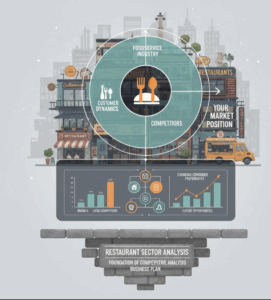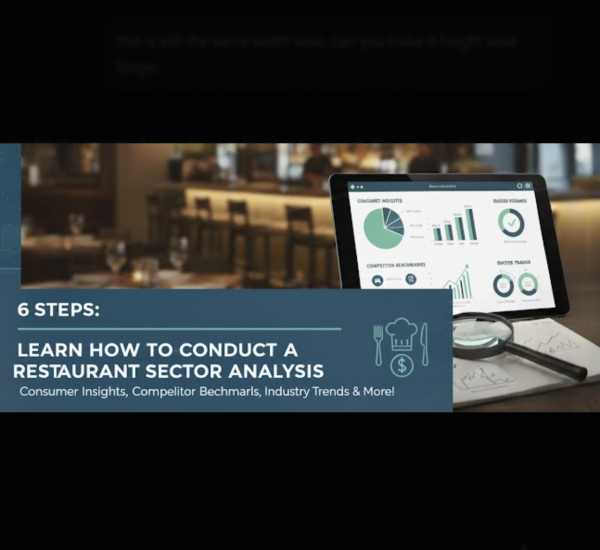The foodservice industry is exciting, but it is also one of the most competitive sectors to enter. Many restaurateurs dive in with passion and great concepts, but without structured analysis, they often struggle. According to the National Restaurant Association, over 60% of new restaurants fail within their first year — often due to a lack of market understanding.
Behind the scenes of a successful restaurant, smart operators use restaurant sector analysis to study market conditions, consumer behavior, competitor performance, and other key metrics. This structured approach provides a clear picture of where opportunities exist and where risks can hold you back.
In this guide, you will learn how to conduct a restaurant sector analysis effectively, step by step, so your business is positioned for long-term growth.
What is a Restaurant Sector Analysis?
A restaurant sector analysis is a structured process of examining the broader foodservice industry, competitors, and customer dynamics. It provides a complete view of your position in the marketplace and how external forces impact your growth.
This type of analysis shows how your brand compares with local competitors and how changing consumer preferences may shape future opportunities.
In simple terms, a restaurant sector analysis acts as the foundation of a competitive analysis business plan.

A Complete 6-Step Framework for Restaurant Sector Analysis
To put these insights into action, here’s a structured six-step framework for carrying out an analysis of restaurant sector effectively.
Step 1: Define Your Purpose and Scope
Every analysis starts with clarity of purpose. You need to decide why you are analyzing the restaurant sector in the first place.
Are you planning to open a new outlet?
Are you expanding into a new city or region?
Or do you want to reposition your restaurant concept to attract a different demographic?
Scope is equally important. Some operators look at the restaurant sector on a local scale, while others take a national or even international perspective to compare growth patterns and customer expectations.
When you begin with a defined goal, you can keep your analysis tightly aligned with business objectives.
Step 2: Understand the Restaurant Sector Landscape
After defining your scope, it’s time to zoom out and look at the bigger picture. The restaurant industry doesn’t operate in a vacuum. Many forces beyond your direct competitors shape how successful your business can be.
Key areas to study include:
Industry size and growth: How big is your target market, and is it expanding or shrinking? For example, fast-casual chains might be booming in certain cities while traditional buffets are on the decline
Customer demand: Pay attention to what diners want. Trends like delivery apps and plant-based options are changing how people choose where to eat.
Economic conditions: Look at factors like disposable income and how much people are spending on food outside the home. These directly influence how often customers dine out.
Technology influence: Digital tools are now central to restaurant operations. Online reservations, mobile ordering, self-service kiosks, and contactless payments all shape the customer experience.
Step 3: Collect Data and Identify Competitors
To position your restaurant effectively, you essentially need to understand who your competitors are. Start by making a list of restaurants and foodservice businesses that attract the same type of customers you’re targeting. To do that, first learn the difference between direct and indirect competitors:
Direct Competitors : These are businesses similar to yours in cuisine, price point, and audience. For instance, a burger chain will compete directly with other burger outlets in the same area.
Indirect Competitors: These may not serve the same menu, but still compete for the same dining occasions. Think of meal kit companies or grocery stores with prepared meals near offices, as all of them can pull customers away from you.
Local vs. International Competitors: Local competitors examples help you see what’s working in your immediate market. On the other hand, international competitor analysis shows how global players adapt to new regions and whether they might enter yours.
You can get accurate insights by collecting data from multiple sources like review platforms, social media, POS systems, and industry reports.
Step 4: Analyze Consumer Behavior and Competitor Performance
After identifying competitors, evaluate how they perform and how consumers respond to them. You can break your analysis into clear metrics like:
Consumer Insights: Examine what customers value most. Look at ratings and feedback trends to align your offerings with customer expectations.
Operational Benchmarks : Compare staffing and service efficiency of competitors. This reveals where they are gaining an edge through better systems.
Menu and Pricing Analysis : This is where you see how value is communicated. Are competitors competing on price or signature dishes? A small adjustment in pricing or a unique menu twist could set your restaurant apart.
SWOT Analysis: Finally, run a SWOT analysis on competitors and your own restaurant. It documents strengths, weaknesses, opportunities, and threats in a structured way. This method provides a clear comparison and highlights priority areas for improvement.
Step 5: Assess Market Trends and Industry Shifts
Consumer preferences and industry dynamics do not remain static. So, your industry analysis for restaurant should not only focus on the present but also look ahead, assessing factors like:
Demographics: Track shifts in income, lifestyle, and age. For example, younger diners often prefer healthier menus and digital-first ordering.
Dining Trends: Follow emerging models like ghost kitchens and the growth of delivery.
Regulations & Tech: Keep up with changing laws and leverage innovations like AI analytics and loyalty apps to stay competitive.
Step 6: Develop a Competitive Analysis Business Plan
The last step is converting insights into a practical strategy. Without action, data holds little value. For that, what you need to do is consider:
Strategic Objectives: Decide what you want to achieve: higher market share, new customer segments, stronger customer loyalty or something else.
Actionable Strategies :Outline the steps needed to meet your objectives. This may include adjusting your menu, refining your pricing, expanding to new locations, or investing in digital marketing.
Performance Metrics: Define how you will measure progress. Key performance indicators may include sales per square foot, average check size, repeat customer rate, or marketing ROI.
Mapchise – Your Competitive Advantage in Restaurant Sector Analysis
A thorough sector analysis requires time, expertise, and reliable data. Many restaurant operators struggle because generic business tools lack industry-specific insights.
That’s where Mapchise comes in. Designed specifically for restaurants, it turns competitor intelligence, menu pricing, customer behavior, and trade area data into clear, actionable strategies.
With features like Customer Explorer, White Space Analysis, and Revenue Attribution, Mapchise helps you identify high-potential locations, refine your offerings, and gain a deeper understanding of your market.
Conclusion
Restaurant sector analysis is a necessity in today’s highly competitive dining industry. By defining your scope, understanding the landscape, identifying competitors, analyzing consumer behavior, tracking industry shifts, and creating a business plan, you can make the right decisions that turn into long-term success.
With powerful tools like Mapchise, you gain the insights needed to outpace competitors and adapt quickly to market changes.
The opportunity is there. Are you ready to seize it? Let us know in the comments section.


